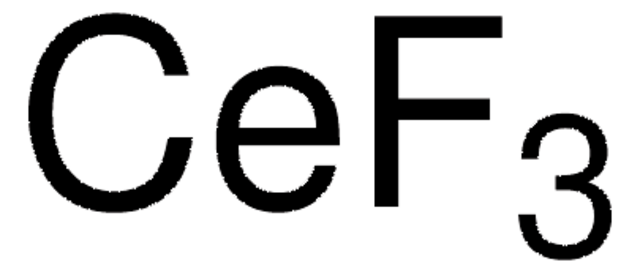All Photos(1)
About This Item
Linear Formula:
Ce(OH)4
CAS Number:
Molecular Weight:
208.15
EC Number:
MDL number:
UNSPSC Code:
12352302
PubChem Substance ID:
NACRES:
NA.23
form:
chunks
Recommended Products
form
chunks
Quality Level
reaction suitability
reagent type: catalyst
core: cerium
concentration
≥47.1% Ce (after ignition to oxide, gravimetric)
SMILES string
O[Ce](O)(O)O
InChI
1S/Ce.4H2O/h;4*1H2/q+4;;;;/p-4
InChI key
WTVAYLQYAWAHAX-UHFFFAOYSA-J
Storage Class Code
11 - Combustible Solids
WGK
WGK 3
Flash Point(F)
Not applicable
Flash Point(C)
Not applicable
Personal Protective Equipment
dust mask type N95 (US), Eyeshields, Gloves
Choose from one of the most recent versions:
Already Own This Product?
Find documentation for the products that you have recently purchased in the Document Library.
Customers Also Viewed
I Frébort et al.
Archives of microbiology, 173(5-6), 358-365 (2000-07-15)
Using transmission electron microscopy, the amine oxidase activity in Aspergillus niger AKU 3302 was localized to the outer side of the cell wall but not inside the cell using the cerium perhydroxide deposition method. The presence of cerium in the
A Vazquez-Torres et al.
Science (New York, N.Y.), 287(5458), 1655-1658 (2000-03-04)
A type III protein secretion system encoded by Salmonella pathogenicity island 2 (SPI2) has been found to be required for virulence and survival within macrophages. Here, SPI2 was shown to allow Salmonella typhimurium to avoid NADPH oxidase-dependent killing by macrophages.
G Nakos et al.
Acta histochemica, 95(2), 203-219 (1993-12-01)
H2O2-generating monoamine oxidase can be visualized in the light microscope with tetrazolium, metal salt (ferricyanide) and coupled peroxidatic oxidation methods. Due to methodological draw-backs these procedures do no allow satisfactory results. In search for an alternative method a light microscopic
G S Groenewold et al.
Physical chemistry chemical physics : PCCP, 9(5), 596-606 (2007-01-24)
Cerium(iii) hydroxy reactive sites are responsible for several important heterogeneous catalysis processes, and understanding the reaction chemistry of substrate molecules like CO, H(2)O, and CH(3)OH as they occur in heterogeneous media is a challenging task. We report here the first
G S Wu et al.
Current eye research, 11(10), 955-961 (1992-10-01)
One of the most prominent features of S-antigen induced uveitis is the massive infiltration of polymorphonuclear leukocytes (PMNs) and mononuclear cells in the ocular tissues and fluids. These inflammatory cells generate reactive oxygen metabolites as microbicidal agents and release these
Our team of scientists has experience in all areas of research including Life Science, Material Science, Chemical Synthesis, Chromatography, Analytical and many others.
Contact Technical Service











